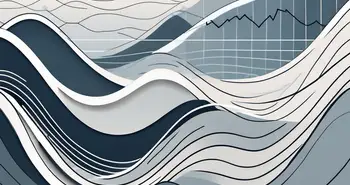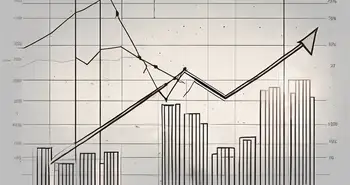Understanding Corrective Waves: A Comprehensive Guide

I have been studying financial markets for over a decade, and one of the key concepts that I have come to appreciate is the importance of corrective waves. In this comprehensive guide, I will help you understand what corrective waves are, how they impact market analysis, and their significance in forex trading. Let's dive in!
Defining Corrective Waves in the Financial Market
Corrective waves, as the name suggests, are market movements that occur against the prevailing trend. In other words, when there is an uptrend, a corrective wave will be a temporary downward movement, and vice versa. These waves play a crucial role in maintaining market balance and ensuring healthy price action.
Corrective waves are fascinating phenomena that provide valuable insights into market dynamics. They are a manifestation of the constant tug-of-war between buyers and sellers, as market participants try to establish dominance. Understanding corrective waves is essential for traders and investors seeking to navigate the complexities of the financial market.
The Basic Principles of Corrective Waves
To understand corrective waves, one must have a grasp of the Elliott Wave Principle. This theory, developed by Ralph Nelson Elliott in the 1930s, explains how market prices move in a series of impulsive waves, followed by corrective waves. The Elliott Wave Principle is based on the idea that market movements are not random but follow a predictable pattern.
According to the Elliott Wave Principle, corrective waves typically retrace a portion of the previous impulsive wave but do not fully negate its progress. This means that even during a strong uptrend or downtrend, there will be temporary counter-trend movements that serve as corrections before the main trend resumes.
Corrective waves are characterized by their distinct price patterns and structures. Within corrective waves, there are two main types:
Types of Corrective Waves
- Zigzag Corrective Waves: Zigzag waves form a three-wave structure with a more significant price correction compared to the impulsive wave. They are commonly labeled as A-B-C waves. Zigzag waves are often seen after a strong impulsive wave and are known for their sharp and swift price movements. Traders closely monitor zigzag waves as they can provide profitable trading opportunities.
- Complex Corrective Waves: Complex corrective waves have a more intricate structure and are labeled with letters such as W-X-Y or W-X-Z. These waves typically result in a longer duration before the main trend resumes. Complex corrective waves are characterized by their overlapping price movements and multiple sub-waves. They can be challenging to decipher but offer valuable insights into market sentiment and potential trend reversals.
It is important to note that corrective waves are not always easy to identify in real-time. Market participants often rely on technical analysis tools, such as wave indicators and pattern recognition, to spot and confirm the presence of corrective waves. By understanding the different types of corrective waves and their characteristics, traders can enhance their ability to make informed trading decisions and capitalize on market opportunities.
The Role of Corrective Waves in Market Analysis
Corrective waves provide valuable insights into market trends and patterns. By recognizing and interpreting corrective waves, traders can predict potential market movements and make informed decisions.
Corrective waves are an essential component of Elliott Wave Theory, a popular technical analysis tool used by traders to analyze market cycles. These waves occur within the larger trend and serve as temporary price reversals before the trend continues. They are characterized by three sub-waves, labeled A, B, and C, and can take various forms, such as zigzags, flats, triangles, or combinations.
When traders study corrective waves, they gain a deeper understanding of the market's psychology and sentiment. Corrective waves reflect the tug-of-war between buyers and sellers, as well as the market's natural tendency to correct itself. By identifying these waves, traders can gain insights into the underlying market dynamics and make more accurate predictions.
Predicting Market Trends with Corrective Waves
Corrective waves help traders anticipate the end of an ongoing trend and identify potential reversal points. By conducting thorough analysis and recognizing the patterns formed by corrective waves, traders can forecast the likelihood of a trend continuation or a trend reversal.
For example, a common corrective wave pattern is the ABC correction. In this pattern, wave A represents the initial price retracement, wave B is a partial recovery, and wave C is the final leg of the correction. By analyzing the length and structure of these sub-waves, traders can estimate the potential price targets and timeframes for the completion of the correction.
Moreover, corrective waves often exhibit specific Fibonacci retracement levels, which traders can use as additional confirmation for their predictions. These retracement levels, such as 38.2%, 50%, or 61.8%, act as support or resistance areas where price reversals are likely to occur.
The Impact of Corrective Waves on Trading Strategies
Understanding corrective waves enables traders to develop effective trading strategies. By integrating this knowledge into their risk management approach, traders can set appropriate entry and exit points and adjust their positions according to the strength and duration of the corrective waves.
For instance, traders can use corrective waves to determine favorable entry points for long or short positions. If a corrective wave is nearing its completion, traders may consider entering a trade in the direction of the larger trend, anticipating the resumption of the primary price movement.
Additionally, the duration of corrective waves can provide valuable insights into the market's momentum. Short and shallow corrective waves suggest a strong and healthy trend, while long and deep corrections may indicate a weakening trend or an impending trend reversal. Traders can adjust their position sizes or even consider exiting the market based on the strength and duration of these corrective waves.
In conclusion, corrective waves play a crucial role in market analysis. By studying and understanding these waves, traders can gain valuable insights into market trends, predict potential reversals, and develop effective trading strategies. Incorporating corrective wave analysis into their decision-making process can significantly enhance traders' ability to navigate the complex and ever-changing financial markets.
Understanding the Corrective Waves Patterns
Corrective wave patterns vary in complexity and structure. Let's explore the two primary forms of corrective waves:
Simple Corrective Waves
Simple corrective waves consist of three waves: a small move against the main trend (wave A), a substantial correction (wave B), and a smaller move back in the direction of the main trend (wave C). These patterns are easier to identify and provide valuable trading opportunities.
Complex Corrective Waves
Unlike simple corrective waves, complex corrective waves have more elaborate structures. They consist of a combination of different sub-waves, typically labeled as W, X, Y, or Z. These patterns require more advanced technical analysis skills and are often associated with longer-term corrections.
The Elliott Wave Theory and Corrective Waves
The Elliott Wave Theory, developed by Ralph Nelson Elliott, provides a framework for understanding the behavior of financial markets. This theory helps to identify the characteristic patterns created by corrective waves and offers insights into market psychology.
The Concept of Elliott Wave Theory
The Elliott Wave Theory suggests that market prices move in repetitive patterns fueled by investor sentiment and psychology. Corrective waves are an integral part of this theory, representing market participants' collective decision-making mechanisms.
The Relationship between Elliott Wave Theory and Corrective Waves
Corrective waves validate the principles of the Elliott Wave Theory by showcasing the natural ebb and flow of market prices. By recognizing these waves, traders can better anticipate market behavior and align their strategies accordingly.
The Significance of Corrective Waves in Forex Trading
In the world of forex trading, corrective waves are of paramount importance. Understanding their role and impact can significantly enhance a trader's ability to navigate the volatile currency markets.
Corrective Waves and Currency Pair Analysis
Analyzing currency pairs involves considering both impulsive and corrective waves. Corrective waves provide crucial insights into the strength of a trend or the potential for a trend reversal. Traders who incorporate corrective wave analysis into their currency pair analysis gain a competitive edge in the forex market.
Risk Management with Corrective Waves in Forex Trading
Corrective waves assist traders in managing risk effectively. By identifying the potential support and resistance levels within corrective waves, traders can set stop-loss orders and take-profit targets strategically. This disciplined approach to risk management can safeguard traders' capital and protect their profits.
As an expert in the field, I have seen numerous traders benefit from incorporating corrective wave analysis into their trading strategies. It provides a systematic framework for understanding market behavior and making informed decisions. Remember, successful trading is not just about timing the market; it's about understanding the mechanics behind price movements and using that knowledge to your advantage.
FAQs: Understanding Corrective Waves
What are corrective waves?
Corrective waves are temporary price movements against the prevailing trend in financial markets. They play a critical role in maintaining market balance.
How do corrective waves impact market analysis?
Corrective waves provide insights into market trends, potential reversal points, and help traders make informed decisions by predicting market movements.
What are the types of corrective waves?
There are two main types of corrective waves: zigzag corrective waves, consisting of three waves labeled A-B-C, and complex corrective waves with more intricate structures labeled W-X-Y or W-X-Z.
How can I integrate corrective waves into my trading strategy?
By understanding corrective waves, traders can develop effective trading strategies that incorporate risk management, set appropriate entry and exit points, and adjust positions based on the strength and duration of the corrective waves.
Why are corrective waves significant in forex trading?
Corrective waves hold particular significance in forex trading as they provide insights into currency pair analysis and assist traders in managing risk effectively, leading to more informed and profitable trading decisions.
I hope this comprehensive guide has shed light on the valuable role that corrective waves play in financial markets, their impact on market analysis, and their significance in forex trading. Incorporating this knowledge into your trading strategy can greatly enhance your chances of success. Remember, as with any trading strategy, practice, discipline, and continuous learning are key to achieving consistent profits.
Ready to take your understanding of corrective waves to the next level and apply it to real-world trading? Look no further than Morpher, the innovative trading platform that revolutionizes investing with blockchain technology. With Morpher, you can trade forex, stocks, cryptocurrencies, and more with zero fees, infinite liquidity, and the ability to start with just $1. Experience the security of a non-custodial wallet, the benefits of 10x leverage, and the unique trading opportunities of Virtual Futures. Sign Up and Get Your Free Sign Up Bonus today to unlock the full potential of your trading strategies!

Disclaimer: All investments involve risk, and the past performance of a security, industry, sector, market, financial product, trading strategy, or individual’s trading does not guarantee future results or returns. Investors are fully responsible for any investment decisions they make. Such decisions should be based solely on an evaluation of their financial circumstances, investment objectives, risk tolerance, and liquidity needs. This post does not constitute investment advice.

Painless trading for everyone
Hundreds of markets all in one place - Apple, Bitcoin, Gold, Watches, NFTs, Sneakers and so much more.

Painless trading for everyone
Hundreds of markets all in one place - Apple, Bitcoin, Gold, Watches, NFTs, Sneakers and so much more.









